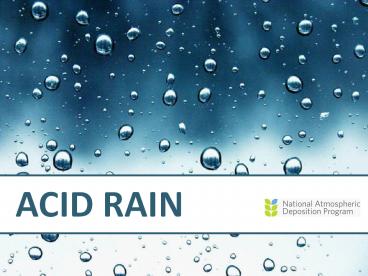ACID RAIN - PowerPoint PPT Presentation
1 / 11
Title:
ACID RAIN
Description:
Rain, snow, fog, or hail that carries pollutants (acids) from the air to the ground. What is acid rain? More About Acid Rain Acid rain: Changes with the weather and ... – PowerPoint PPT presentation
Number of Views:91
Avg rating:3.0/5.0
Title: ACID RAIN
1
ACID RAIN
2
What is acid rain?
Rain, snow, fog, or hail that carries pollutants
(acids) from the air to the ground.
3
More About Acid Rain
- Acid rain
- Changes with the weather and seasons
- Changes within short distances
- Can carry pollutants long distances, even to
other countries
4
Natural Causes of Acid Rain
- Lightning
- Volcanoes
- Rotting plants and grasses
5
Man-Made Causes of Acid Rain
- Exhaust from cars, trucks, and buses
- Power plants that burn coal
- Pollution from industry
6
Location of Acid Rain
- Highest in areas with
- Large cities
- Large population
- Heavy car traffic
7
Acid Rain Can Be Harmful
- Forests Lakes
- Leaves and trees become damaged
- Trees will more likely have a disease or
insect problem - Certain types of fish may die
- Plants Crops
- Plant roots cant grow properly
- Soils lose nutrients that are healthy for
plants
8
Acid Rain Can Be Harmful
- Humans
- People can have respiratory problems when
they inhale small droplets (fog) - Lead and copper from rusty pipes can dissolve
into drinking water - Man-Made Materials
- Metal structures and cars become corroded
- Limestone buildings, tombstones, statues, and
monuments wear down more quickly
9
Is Acid Rain Still a Problem?
10
Add in the last page slide here
11
For more information about this presentation or
the NADP, please contact NADP PROGRAM
OFFICE 2204 Griffith Drive Champaign, IL
61820 217-333-7871 E-mail nadp_at_isws.illinois.ed
u http//nadp.isws.illinois.edu
- The NADP is National Research Support Project-3
A Long-Term Monitoring Program in Support of
Research on the Effects of Atmospheric Chemical
Deposition. More than 250 sponsors support the
NADP, including private companies and other
nongovernmental organizations, universities,
local and state government agencies, State
Agricultural Experiment Stations, national
laboratories, Native American organizations,
Canadian government agencies, the National
Oceanic and Atmospheric Administration, the
Environmental Protection Agency, the Tennessee
Valley Authority, the U.S. Geological Survey, the
National Park Service, the U.S. Fish Wildlife
Service, the Bureau of Land Management, the U.S.
Department of Agriculture - Forest Service, and
the U.S. Department of Agriculture - National
Institute of Food and Agriculture, under
agreement no. 2008-39134-19508. Any opinions,
findings, and conclusions or recommendations
expressed in this publication are those of the
author(s) and do not necessarily reflect the
views of the sponsors or the Illinois State Water
Survey.































